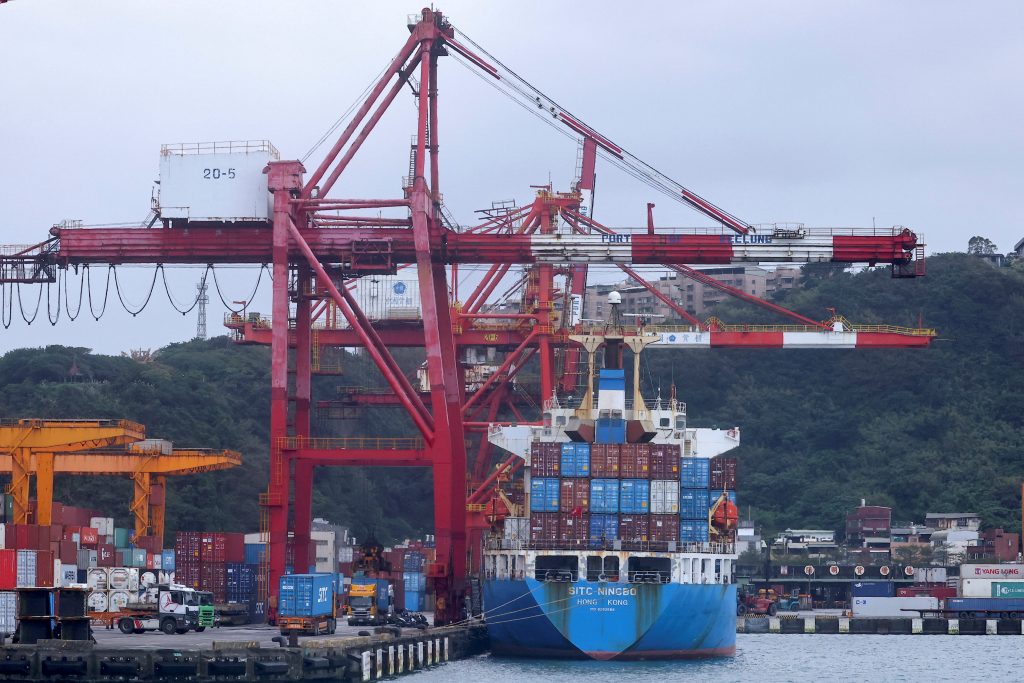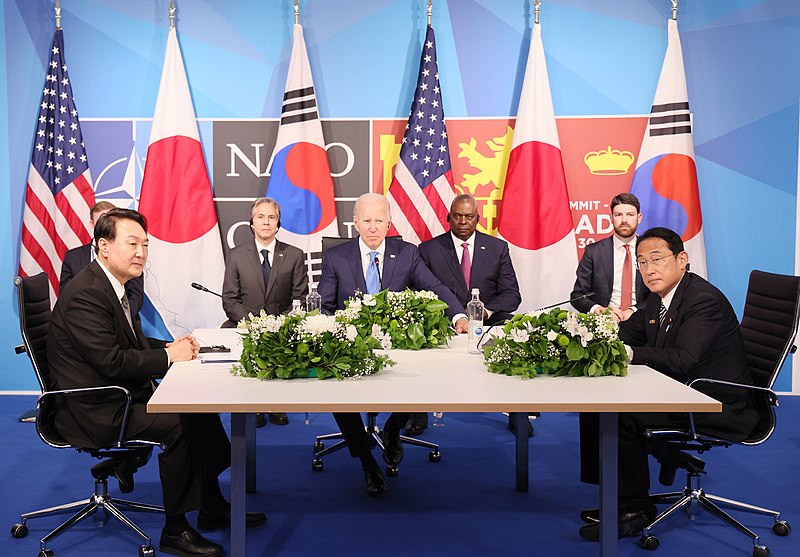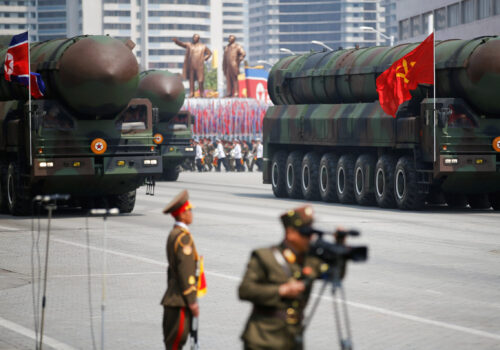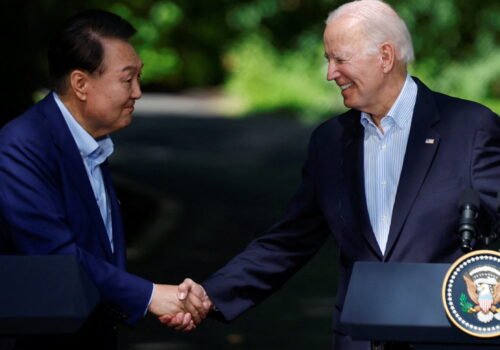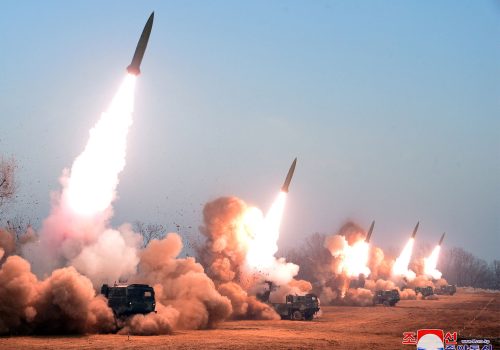A US-South Korea alliance strategic memo on countering Beijing’s economic coercion
TO: Republic of Korea National Security Office director, minister for trade, and minister of trade, industry, and energy; US national security advisor, trade representative, and commerce secretary
SUBJECT: An alliance approach to countering Beijing’s economic coercion
Bottom line up front: The economic interdependence of the Republic of Korea (ROK), the United States, and other Indo-Pacific countries with the People’s Republic of China (PRC) is enabling Beijing to pose threats to key US and ROK national security interests—particularly through the threat of economic coercion and manipulation. To reduce the risks associated with economic interdependence with the PRC, Seoul and Washington should utilize a combination of protection, collaboration, and institutionalization. The United States and South Korea should align their strategies in advanced technologies crucial to national security, operationalize the trilateral partnership with Japan to enhance the resilience of supply chains, and reinforce the rules-based economic system in the Indo-Pacific to reduce PRC economic coercion and technological theft.
Background: Economic interdependence of Indo-Pacific countries with China is enabling Beijing to threaten the interests of Seoul and Washington
The PRC has long used its economic leverage—and implicit and explicit threats of coercive economic measures in recent years—to affect the policy decisions of countries in the Indo-Pacific region. Both Seoul and Washington have sought to counter such behavior yet have been cautious about confronting Beijing or strongly retaliating for such practices, in part due to their own considerable economic interdependence with the PRC.
For more than two decades, South Korea has enjoyed strong trade relations with the PRC that have come with implicit and increasingly explicit threats of economic retaliation for angering Beijing. Seoul is thus understandably hesitant at times to undertake policies that risk provoking Beijing. This reluctance can lead to friction in the ROK-US alliance when it factors into a decision with national security implications for both the ROK and United States.
- In a notable example, Beijing warned Seoul against expanding US missile defense assets in South Korea, claiming that hosting such systems—particularly the US Terminal High Altitude Area Defense (THAAD) system—would make the ROK part of a “US missile defense shield.” In 2017, after a long period of ROK-US consultations and a bilateral decision to deploy THAAD despite Beijing’s objections, a US THAAD battery began arriving in South Korea in response to increasing missile and nuclear threats from North Korea. Beijing retaliated with a wide range of economic measures. This resulted in an estimated nearly $2 billion in losses for the South Korean company, Lotte, which had provided the land for the THAAD deployment. This also harmed various sectors of the ROK economy, particularly tourism and entertainment, which led to significant backlash from the ROK public.
After nearly two decades of the PRC being South Korea’s top market for trade, the United States returned to that position in 2023. However, Beijing still makes up a significant portion of the market for South Korean businesses and Seoul maintains a strong interest in keeping the PRC as a key trading partner. Currently, under President Yoon Suk Yeol, Seoul is taking a much more hard-line stance toward Beijing than in previous administrations, indicating an increase in appetite for stronger measures to counter PRC economic coercion—though perhaps just temporarily, as South Korean policies are subject to fluctuation due to political transitions and public opinion.
For its part, the United States is pursuing approaches to reduce economic interdependence with the PRC, as part of a strategy termed “derisking,” in favor of “friend-shoring” trade relationships with allies and partners. In recent years, the United States also has been more willing to take a tougher stance vis-à-vis China on security and economic issues in general, accepting greater risk of economic retribution.
Recommendations for US and South Korean leadership:
Enhance integration and alignment of US-ROK strategies and policies in advanced technology sectors that are vital to national security. To reduce vulnerability to PRC disruptions, Seoul and Washington should divert critical components of their defense industrial base away from Beijing. The United States and South Korea individually will find it more difficult to remain competitive with the sheer scale and rapidity of Chinese military technology advancements than if they work together. It is thus in their best interest to coordinate with one another, as trusted allies in the Indo-Pacific region, on a bilateral, proactive protection system in core technology areas that are crucial to their defense systems.
- In Washington, the Department of Justice and Department of Commerce have established a Disruptive Technology Strike Force to defend against efforts by adversaries to steal advanced technologies. Seoul has similarly implemented a Technology Protection Strategy to coordinate government responses to attempts by adversaries to unlawfully access core technologies. These individual strategies can carry more weight and efficacy when they are fully integrated in a bilateral US-ROK approach to counter malign PRC efforts.
- Such efforts’ success will require greater alignment between US and ROK government agencies. For instance, the US National Science Foundation and ROK Ministry of Science and Information and Communication Technology convene annually to strengthen cooperation on digital economic policy issues in the public sector. To advance bilateral economic relations into a whole-of-county response to PRC economic threats to national security, these government agencies should also enable funding and other incentives to private-sector defense companies and technology manufacturers that invest in and produce these critical technologies.
- Investments by US companies and ROK companies, respectively, in the advanced technology sectors of the allied country have mutually reinforcing and long-term benefits. South Korea’s Samsung applied for tax breaks to construct eleven semiconductor plants throughout the United States in the next twenty years. For the United States, these plants will enhance the resiliency of domestic supply chains by developing a high-skilled workforce that is integral to the production of sensitive technologies. For South Korea, this project will help Samsung meet the ever-growing demands of a global manufacturing company and narrows its gap with competitors.
Operationalize the trilateral partnership with Japan to enhance supply chain resiliency. In the face of an aggressive Chinese economic posture, friend-shoring among the United States, South Korea, and Japan will be vital for bolstering each country’s defense industry sectors.
- The United States, South Korea, and Japan have already launched a pilot program for a supply chain early warning system with the aim of preventing supply chain disruptions by proactively sharing key resources to offset blockages in the production and logistics networks. Trilateral cooperation can also encompass the mapping of existing stockpiles of key resources for critical supply chains and identification of potential vulnerabilities to each country’s security infrastructure.
There is a need for immediate trilateral action to address deep vulnerabilities in the critical mineral sector.”
—Minister Yeo Han-Koo, former ROK minister of trade
- Rare metals such as gallium and germanium, which are essential components in semiconductors, are prime targets of opportunity for testing the newly established supply chain early warning system. In July 2023, despite already dominating the world’s production of these materials at 85 percent and 60 percent, respectively, China restricted the export of these metals. As a result, Seoul, Washington, and Tokyo are facing supply chain issues as their access to a significant proportion of the world’s gallium and germanium has been suddenly restricted. Given the vital role that semiconductors, and consequently these metals, play in the US-ROK-Japan defense apparatus, it is imperative that the group find alternative sources.
- To avoid overdependence on Beijing for materials so critical to national security, the three countries should pool their resources through the Minerals Security Partnership to offset future supply disruptions. This approach can be replicated for other materials that are key components of the security architecture. In the event that one of the three countries faces a shortage of a materials—likely due to PRC economic retaliation—the other two countries can temporarily provide supplies of that material through contingency transactions or government procurements in the form of a supply swap.
- The US-ROK-Japan partnership should also coordinate the placement of strategic export controls on sensitive technologies to the PRC. Seoul, Washington, and Tokyo can redirect any existing flows of advanced technologies such as machine tooling and artificial intelligence chips away from Beijing and furnish supply to each other instead. This will effectively reduce the flow of critical defense technologies to adversaries.
Promote and enforce the rules-based system in the Indo-Pacific economic security architecture alongside like-minded partners. The United States and South Korea can lead efforts to ensure the regional trade system remains free and open to all participating economies. They can offer smaller Indo-Pacific economies with a liberal alternative model to the PRC, which often invokes predatory lending, corruption, and abuse of labor rights. The United States and South Korea should:
- Spearhead rulemaking to promote secure and resilient supply chains through multilateral partnerships with like-minded nations such as through the Indo-Pacific Economic Framework for Prosperity (IPEF). This would include enforcing transparent policymaking and implementation to allow for a fair and inclusive system. The United States and South Korea also can share best practices with IPEF members such as promoting capacity building in critical and emerging technologies, while continuing to uphold democratic values.
- Arm emerging economies with the toolkit to thwart attempts by Beijing to bully them into aligning their economic and political policies with the PRC. Use available tools such as the IPEF Supply Chain Crisis Response Network to share information and establish early warning alerts for disruptions to critical supply chains. With IPEF’s diverse membership base with various areas of comparative advantage, the group can collectively decrease the consequences of Chinese economic coercion.
Democratic nations should emphasize that they will not bow to economic coercion.”
—Dr. Robert Dohner, former US deputy assistant secretary of treasury
- In response to the PRC’s next use of economic coercion against an Indo-Pacific country, Seoul and Washington should gather like-minded Indo-Pacific partners to issue a joint statement condemning the use of coercive tactics. The joint statement should emphasize that while signatories do not seek to harm Chinese economic progress, any attempts to interfere with the integrity of democratic institutions and economic prosperity will not be tolerated. Given their proximity to and degree of economic interconnectivity with the PRC, small Indo-Pacific countries are particularly vulnerable to potential acts of economic coercion. However, they are often reluctant to take a firm stance against the PRC without strong support from leading economies like South Korea and the United States, which can help them withstand potential economic repercussions.
About the authors
Kyoko Imai is the primary author for this policy memorandum and the associate director of the Atlantic Council’s Indo-Pacific Security Initiative, housed in the Scowcroft Center for Strategy and Security.
Markus Garlauskas is the co-author for this policy memorandum and the director of the Atlantic Council’s Indo-Pacific Security Initiative.
Heemin Yang is a contributor and an associate with Forward Risk.
The research for this policy memorandum was made possible by the support of the Korea Foundation, but it represents the views of the authors rather than those of the Korea Foundation, the Atlantic Council, or any government entity.
Related content

Indo-Pacific Security Initiative
The Indo-Pacific Security Initiative works with US, allied, and partner governments and other key stakeholders to shape strategies and policies to mitigate the most important rising security challenges facing the region, including China’s growing threat to the international order and North Korea’s destabilizing nuclear weapons advancements. IPSI also addresses opportunities for cooperation in the region, such as transforming regional security architectures, harnessing emerging technologies, and developing new mechanisms for deterrence and defense cooperation.
